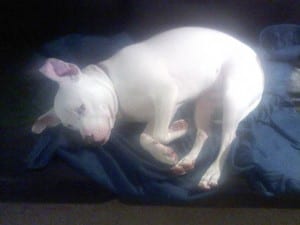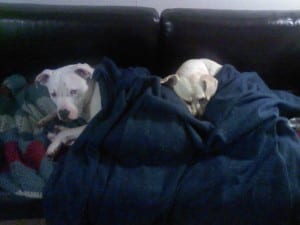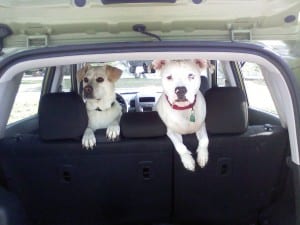So having talked fairly generally about what was going on at the Austin Humane Shelter during 2012 (with some comments about my involvement) in Volunteering at the Austin Humane Shelter Part 6, Part 7 and Part 8, I want to switch gears into self-indulgent prattling mode and talk about how it was (or wasn’t) affecting me personally. Some of this will detail my time at the shelter, some of it will tie in with stuff about my own dogs ALFIE and NORMAN, who I have written about in their own article series.
Don’t be surprised if this is a little bit all over the map as I’m jumping back and forth across topics. I wasn’t able to find any good flow for this part of the story. Also my system ate what I had initially written so I had to start from scratch (because computers are evil).
Table of Contents
Back to Me
As I mentioned in Part 6, I had moved up to full blue BRATT in 2011 and never lacked for anything to do. I forget how many shifts I was doing at the time (currently I am at the shelter without fail three days per week and often do a fourth special event or 1:1 training or something).
During the majority of the summer, I had just ground along day to day to day. Like I said earlier, I was a full blue BRATT and that meant focusing my time on the BB dogs which we had plenty and plenty of. Between that and other things to do, I was plenty busy. I was still training and racing (as detailed in other article series), it was pretty standard business.
Then the shit hit the fan starting with the Bastrop Hoarding event. I talked about showing up that Saturday not knowing what to expect and being overwhelmed by the sheer number of dogs and the fact that the shelter looked like a dog shanty town. But after that initial reaction, there was nothing to do but to just get it done. Honestly, I kind of like crisis situations, I have a bit of that “save the world” mentality (common to many who pursue health related field or volunteering) and this triggered that.
And for all of the events that would occur where we would be fairly overwhelmed with dogs (and understaffed on volunteers), I was just a dog walking machine throughout the entire time. I was efficient and psychotically driven, I would do everything I could to get as many dogs as possible out during the situations where we were overfull. If there is one drawback it’s that I’ve had some trouble moving back to a more normal dog walking rhythm since the disasters have cleared up.
I still tend to just want to make sure everyone gets out to potty and get at least some time; putting in extra to socialize with them or do much in the way of training is just out of the question. At most, I tend to focus these days on basic leash walking. I’m of the opinion that this is one of the most important ones and it’s one I can do while I take the dogs out.
I just haven’t had time to work on other stuff to any great degree. If I know that we will get everyone out in time, I’ll force myself to slow down and work on some basic training like attention or eye contact or whatever. Lately it seems like there just hasn’t been the time.
Anyhow, as a full blue BRATT, I could pull dogs for lower level volunteers (this was an immense help as it allowed us to take care of more than one dog or set of dogs at a time; the lower level BRATT’s can watch them in the runs while we walk) and I’d often be juggling 2-3 dogs in my head: the one I was walking, the first dog I’d left in the runs with one volunteer and the second dog I’d left with another volunteer. Just keeping track of who needed to go back, who I needed to bring a dog, who was going out next, what I needed to mark on the board for each dog to keep track.
I’ve got a good memory and organizational skills which helped and I’d just keep up this relentless pace getting dogs out all summer. My ethnic background lets me handle the heat pretty well, I don’t need a lot of fluid and I don’t dehydrate so I’d just hammer for 3 straight hours in the brutal Austin heat.
The only other parts of my life for the first half of the year were working with ALFIE at home and training so it was all good. Walk ALFIE, train, shelter, train, walk ALFIE. It was hot and it was tiring but I was still having fun and still helping the dogs.
Norman: Part 1
Mind you, towards the end of this was when NORMAN would enter my life but I already told that story in detail elsewhere and won’t repeat it here. I had taken him home to foster in July, after the real craziness of the hoarding event had occurred but at least during the time that some of the other disasters I described were occurring.
He was a headache. He was still very much a puppy, his breed (a pitbull mix) gave him high energy, and he was wound a bit tight. He also wasn’t well socialized, they had found him up on Jollyville road with an injured back leg as a puppy and he’d probably been a stray prior to that. He wasn’t potty trained and there were a lot of accidents (all my fault, make no mistake).
More seriously, he had some separation anxiety and would tear stuff up if I left the house for extended periods (he went through a lot of my socks, a couple of dog beds, killed a Playstation3 controller and TV remote and I’m probably forgetting some stuff).
He even dug a 6″ square hole in the carpet by the front door at one point, dogs apparently do this when they lose their shit, trying to dig their way out to find their human. But I had taken him into the house understanding the responsibility so that’s what it was. And, mind you, he wasn’t always a monster and did have periods of calm. Like when he was sleeping.
.

- .
Honestly, it’s probably a real good thing he was cute (and at least sometime a lot of fun to have around) or I’d have gotten rid of his ass. I was really close a few times and thought about it but I’m getting ahead of myself. Mind you, my time with ALFIE had given me a bit of a false sense of ease (and I would never never never never adopt another puppy; as I tell people now the cute is temporary but the pain in the assedness lasts a long time).
ALFIE was older when I adopted him, past the puppy stage, and had some training already. He was also temperamentally calmer (in relative terms at least) than NORMAN. ALFIE had his issues but they were nothing compared to what I’d be dealing with with NORMAN. Because, I’d come to find out fairly shortly, had he stayed at the shelter, he would have been a yellow level dog.
So in the same way that I’d adopted ALFIE when he was a color level above what I was trained to handle (he was BB when I was blue dog) I had managed to do the same with NORMAN (who would have been yellow when I was only BB). Which also meant that, at a fundamental level, I didn’t have the training skills to really deal with him. But that would soon change.
Yer Yellow: Part 1
Because about two months into having NORMAN at home (so about September, while much of the mess at the shelter was still going on), I was approached by one of the Orange BRATTs about taking the Yellow class. Because while you can voluntarily take the blue dot or full blue classes, you have to be selected to move up further than that.
Presumably this is based on reliability and consistency (which I had in spades) as well as having shown some ability to work with them (that I liked to think I had). At the higher levels, not everybody is equipped or able to handle those dogs and that puts both the dogs and the handler at risk. So not everyone is given the option to move up.
Of course, not everyone wants to move up in the first place. I’m not saying this as a negative or a criticism at all. The shelter needs volunteers at every color level and better to have someone stay at the level they are comfortable up than to move up and quit because they don’t like it.
I know of volunteers who have stayed at, for example, blue dot or full blue for extended periods. That’s simply where they are happy and that means they are there consistently and that’s what matters. Moving up isn’t expected or an obligation and I don’t want to make it sound like it is (or that not moving up is somehow bad).
In any case, I had apparently made the cut and been given the opportunity to move up to yellow level. On the one hand, it was quite the honor since it told me that I was doing a good job (which, my current laziness with this site notwithstanding, is important to me). On the other hand, I wasn’t sure, especially given what I was dealing with at home with NORMAN, if I wanted or could handle the extra stress and responsibility.
I had, at this point, had some exposure to Yellow dogs. Often I had worked with dogs who were BB who were then moved up to Yellow so I had some idea of what to expect, or had gotten to walk a yellow dog when there wasn’t a high level volunteer and I was given permission. And I wasn’t sure if I was ready for it.
So I sat on the fence for a couple of weeks. I was getting some pressure from higher level volunteers (in the sense that they just kept asking me if I was going to take the class which at least suggested that they really wanted me to) and I went back and forth on it. I could always take the next class a few months later but I balanced that against wanting to help more dogs (and learn more about dog training and maybe get NORMAN under control) which I balanced against not being sure I wanted the responsibility…you get the idea.
And to break up this dense block of text here’s a picture of NORMAN and ALFIE after they took over my couch.
.

Of course, I finally decided to take it as I knew I would. It’s weird, I do this sometimes, I know exactly what I’m going to do but play this game with myself where I pretend to debate it in my own head weighing the pros and cons. Then I do it anyhow. I know at the outset what I’m going to do but have to at least pretend to deliberate. So I decided to take the class.
Like the full blue class it was 5 weeks of classes over 6 weeks, they give you one week in the middle to practice and absorb the information. And it was almost overwhelming. We had weekly readings and copious notes and handouts along with being taught a huge number of new games and techniques to train the dogs.
Week 2, where we dealt with leash walking, nearly buried me. It was just so many different techniques and so much information. Of course we were also working hands on with the yellow dogs now to start getting experience with them. So now I was walking a select set of yellow dogs (they usually assign the classes the relatively easier dogs of the new color level) along with my normal BB, etc. duties.
Yer Yellow: Part 2
A big shift with the yellow class was moving into clicker training. Prior classes had used a mark work (in this case a high-pitched ‘YES!) to mark behavior but now we were getting more technical and that meant clickers. The reason they wait is that there is a timing issue along with being able to wrangle your leash, the dog, treats and a clicker all at the same time. It’s not that it’s that hard, but it does take some practice. So they don’t teach it in the lower level classes.
And while there isn’t much of a fundamental difference between a mark word and a clicker, those in the know feel that the clicker is more consistent (always the same sound), may activate different neural pathways (noise vs. word) and simply works better; if nothing else it lets you pinpoint the behavior a lot more accurately when you get the timing down. This isn’t as critical with the BB and blue dot dogs but, as I’d soon learn, can be with yellow level dogs (which I’ll discuss in more detail on Friday).
All of this would end up triggering my normal obsessive behavior patterns shortly thereafter as I’d throw myself into the science and practice of clicker training and everything related. I’d scour the web, read everything I could get my hands on, I still maintain that you could clicker train a human.
Amusingly there is a group using what they call TAGteach, Teaching with Acoustical Guidance, to work with gymnasts, using the clicker to mark body positions. Mind you, that all of this happened to fit in with things I was researching (basically looking addiction, reward physiology, behavioral reinforcement and habit establishment/change) didn’t hurt.
So far as actual techniques, there was a lot of advanced leash walking, how to deal with leash biting, build relationship and calmness and a host of other stuff. Most of it was pretty easy to understand conceptually (if not always easy to implement) with one exception and that is counter-conditioning for reactivity.
This is a game called click to calm and it just took me weeks to wrap my head around it (I’d send endless irritating emails to one of the Orange BRATTs who was teaching the class). Here’s another dog picture with no relation to what I’m talking about because big blocks of dense text are irritating.
.

.
But I needed to understand it as much for the shelter as the fact that I needed to use it with both of my dogs. It was full on dog training at this point and, if I’m honest, taking the class was as much about the shelter as it was giving me the tools to work with my own dogs. Like I said, NORMAN would have been yellow and taking the class gave me the tools to really work with him. Of course, those techniques work just fine with lower level dogs so I used it with ALFIE as well (especially the click to calm game to work on his reactivity).
We also had to learn a bit about breed characteristics (I’m still very bad at breed identification) because another requirement was that we start helping with adoption counseling. That is, working with the public to make sure that the dog they are interested in is a good fit for them, counseling them on the dog they may be interested in, etc.
This is a place where volunteers have an advantage over staff; since we spend most of the time with the dogs we often know them better in terms of their real world behavior (rather than what’s written in the folder). And when the public is interested in yellow or orange dogs (remember: often big time behavioral issues), you need them to be fully aware of what they are going into (some dogs actually require counseling with a higher level BRATT before adoption). And the yellow and orange volunteers have that information.
It’s something I actually really enjoy doing, it’s a more direct way to help dogs find forever homes. I get to interact with the potential adopters and there’s something nice about doing the counseling (or dog introduction) for a dog I’ve been working with and to see them go home. As well, folks who have worked with the dogs often want to know about who adopted them, when a volunteer does the counseling, we can share that information.
Finally, we were supposed to have done a module on playgroups. Although it hasn’t happened often in the last year (due to time), when possible we try to play dogs with each other in our auditorium both to let them get some energy out as well as to help with dog-dog socializing (and to identify potential problems).
I had helped out with them previously but you can get qualified to do them as a yellow BRATT on your own (or at least with established play groups). Unfortunately, the outbreak prevented us doing that since we couldn’t safely let dogs play together during that time period.
But it was an exhausting, overwhelming 6 weeks (ultimately worth it, of course). I was now working with yellow dogs consistently at the shelter, along with applying those techniques at home. Which ended up taking a lot out of me for quite some time. The shelter wasn’t quite as fun once I moved up to yellow, and my home situation wasn’t helping with my overall attitude.
Read Volunteering at the Austin Humane Shelter: Part 10.
Facebook Comments